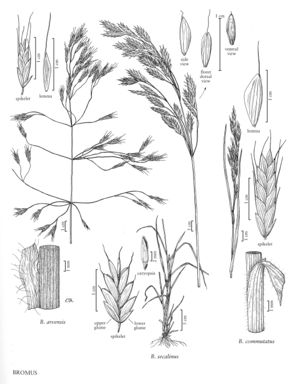Difference between revisions of "Bromus commutatus"
FNA>Volume Importer |
imported>Volume Importer |
||
| (7 intermediate revisions by 2 users not shown) | |||
| Line 4: | Line 4: | ||
|publications= | |publications= | ||
|common_names=Meadow brome;Hairy chess | |common_names=Meadow brome;Hairy chess | ||
| + | |special_status={{Treatment/ID/Special_status | ||
| + | |code=I | ||
| + | |label=Introduced | ||
| + | }} | ||
|basionyms= | |basionyms= | ||
|synonyms={{Treatment/ID/Synonym | |synonyms={{Treatment/ID/Synonym | ||
|name=Bromus secalinus subsp. decipiens | |name=Bromus secalinus subsp. decipiens | ||
| − | |authority= | + | |authority= |
| + | |rank=subspecies | ||
}} | }} | ||
|hierarchy=Poaceae;Poaceae subfam. Pooideae;Poaceae tribe Bromeae;Bromus;Bromus sect. Bromus;Bromus commutatus | |hierarchy=Poaceae;Poaceae subfam. Pooideae;Poaceae tribe Bromeae;Bromus;Bromus sect. Bromus;Bromus commutatus | ||
| Line 28: | Line 33: | ||
-->{{#Taxon: | -->{{#Taxon: | ||
name=Bromus commutatus | name=Bromus commutatus | ||
| − | |||
|authority=Schrad. | |authority=Schrad. | ||
|rank=species | |rank=species | ||
| Line 35: | Line 39: | ||
|basionyms= | |basionyms= | ||
|family=Poaceae | |family=Poaceae | ||
| + | |illustrator=Cindy Roché | ||
| + | |illustration copyright=Utah State University | ||
|reference=None | |reference=None | ||
|publication title= | |publication title= | ||
|publication year= | |publication year= | ||
| − | |special status= | + | |special status=Introduced |
| − | |source xml=https:// | + | |source xml=https://bitbucket.org/aafc-mbb/fna-data-curation/src/200273ad09963decb8fc72550212de541d86569d/coarse_grained_fna_xml/V24/V24_325.xml |
|subfamily=Poaceae subfam. Pooideae | |subfamily=Poaceae subfam. Pooideae | ||
|tribe=Poaceae tribe Bromeae | |tribe=Poaceae tribe Bromeae | ||
Latest revision as of 16:23, 11 May 2021
Plants annual. Culms 40-120 cm, erect or ascending. Lower sheaths densely hairy, hairs stiff, often retrorse; upper sheaths pubescent or glabrous; ligules 1-2.5 mm, glabrous or pilose, obtuse, ciliolate; blades 9-18 cm long, 2-4 mm wide, pilose on both surfaces. Panicles 7-16 cm long, 3-6 cm wide, open, erect to ascending; branches sometimes longer than the spikelets, slender, ascending to spreading. Spikelets 14-18(30) mm, oblong-lanceolate, terete to moderately laterally compressed, not purple-tinged; florets 4-9(11), bases concealed or visible at maturity; rachilla internodes 1.5-2 mm, concealed or visible at maturity. Glumes usually glabrous, sometimes scabrous or pubescent; lower glumes 5-7 mm, 5-veined; upper glumes 6-9 mm, 7(9)-veined; lemmas 8-11.5 mm long, 1.7-2.6 mm wide, elliptic to lanceolate, coriaceous, backs usually glabrous, distinctly 7(9)-veined, not ribbed, rounded over the midvein, margins scabrous or pubescent, bluntly angled, inrolled or not at maturity, apices acute to obtuse, bifid, teeth shorter than 1 mm; awns 3-10 mm, straight, arising less than 1.5 mm below the lemma apices, awn of the lowest lemma shorter than the others; anthers 0.7-1.7 mm. Caryopses equaling or shorter than the paleas, weakly to strongly inrolled. 2n = 14, 28, 56.
Discussion
Bromus commutatus grows in fields, waste places, and road verges. It is native to Europe and the Baltic region; in the Flora region, it is found mainly in the United States and southern Canada. Hildemar Scholz (pers. comm.) recognizes three subspecies of B. commutatus in Europe; no attempt has been made to determine which subspecies are present in the Flora region.
Selected References
None.
